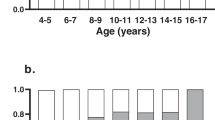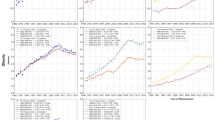Abstract
BACKGROUND:
School entry marks a tremendous change in the children's life style, which might well be relevant for the emergence of overweight. Previous studies suggested a dramatic increase in the prevalence of overweight during this age.
OBJECTIVE:
To compare the age-specific balance between the incidence and remission of overweight between pre-school and primary school age children.
DESIGN:
We combined the data of three studies that had been conducted within the setting of the compulsory school entry health examination in different parts of Germany: one covering retrospective cohort data from age 2 to school entry (n=5045), one prospective data from school entry to fourth grade (n=1235) and one comprising both (n=1194). We assessed the rates of incidence and remission of overweight and obesity from age 2 to school entry and from school entry to fourth grade.
RESULTS:
In pre-school age, the pooled incidence for overweight was 8.2% (95% confidence interval: 7.5, 8.9) compared with a remission rate of 62.6% (58.4, 66.7), yielding a prevalence at school entry of 10.7% (9.9, 11.5). In primary school age, the pooled incidence for overweight increased to 14.6% (13.1, 16.1), whereas the remission rate was reduced to 17.7% (13.8, 22.3), yielding a prevalence of 23.7% (22.0, 25.4) in fourth grade. A similar pattern was observed for obesity.
CONCLUSIONS:
While high remission rates balance incident overweight in pre-school years, the dramatic increase in the prevalence of overweight and obesity in primary school years reflects a higher incidence and even more a lower remission rate. Obesity prevention programs in primary school age are mandatory and need to address primary and secondary prevention elements.
This is a preview of subscription content, access via your institution
Access options
Subscribe to this journal
Receive 12 print issues and online access
$259.00 per year
only $21.58 per issue
Buy this article
- Purchase on Springer Link
- Instant access to full article PDF
Prices may be subject to local taxes which are calculated during checkout
Similar content being viewed by others
References
Plachta-Danielzik S, Pust S, Asbeck I, Czerwinski-Mast M, Langnase K, Fischer C et al. Four-year follow-up of school-based intervention on overweight children: the KOPS study. Obesity (Silver Spring) 2007; 15: 3159–3169.
Fry C, Heinrich J . Trends and predictors of overweight and obesity in East German children. Int J Obes Relat Metab Disord 2003; 27: 963–969.
Kurth BM, Schaffrath Rosario A . The prevalence of overweight and obese children and adolescents living in Germany. Results of the German Health Interview and Examination Survey for Children and Adolescents (KiGGS). Bundesgesundheitsblatt Gesundheitsforschung Gesundheitsschutz 2007; 50: 736–743.
Katz DL, O’Connell M, Njike VY, Yeh MC, Nawaz H . Strategies for the prevention and control of obesity in the school setting: systematic review and meta-analysis. Int J Obes (Lond) 2008; 32: 1780–1789.
Campbell K, Waters E, O’Meara S, Summerbell C . Interventions for preventing obesity in childhood. A systematic review. Obes Rev 2001; 2: 149–157.
Doak CM, Visscher TL, Renders CM, Seidell JC . The prevention of overweight and obesity in children and adolescents: a review of interventions and programmes. Obes Rev 2006; 7: 111–136.
Toschke AM, Beyerlein A, von Kries R . Children at high risk for overweight: a classification and regression trees analysis approach. Obes Res 2005; 13: 1270–1274.
Plachta-Danielzik S, Bartel C, Raspe H, Thyen U, Landsberg B, Muller MJ . Assessment of representativity of a study population - experience of the Kiel Obesity Prevention Study (KOPS). Obes Facts 2008; 1: 325–330.
Danielzik S, Pust S, Landsberg B, Muller MJ . First lessons from the Kiel Obesity Prevention Study (KOPS). Int J Obes (Lond) 2005; 29 (Suppl 2): S78–S83.
Müller MJ, Asbeck I, Mast M, Langnase K, Grund A . Prevention of obesity--more than an intention. Concept and first results of the Kiel Obesity Prevention Study (KOPS). Int J Obes Relat Metab Disord 2001; 25 (Suppl 1): S66–S74.
Bolte G, Heissenhuber A, von Kries R, Liebl B, Zapf A, Wildner M et al. Health monitoring units in Bavaria. Concept, aims and thematic focus of the first survey on children's environment and health. Bundesgesundheitsblatt Gesundheitsforschung Gesundheitsschutz 2007; 50: 476–483.
Cole TJ, Bellizzi MC, Flegal KM, Dietz WH . Establishing a standard definition for child overweight and obesity worldwide: international survey. BMJ 2000; 320: 1240–1243.
Nader PR, O'Brien M, Houts R, Bradley R, Belsky J, Crosnoe R et al. Identifying risk for obesity in early childhood. Pediatrics 2006; 118: e594–e601.
Kim J, Must A, Fitzmaurice GM, Gillman MW, Chomitz V, Kramer E et al. Incidence and remission rates of overweight among children aged 5 to 13 years in a district-wide school surveillance system. Am J Public Health 2005; 95: 1588–1594.
Juliusson PB, Eide GE, Roelants M, Waaler PE, Hauspie R, Bjerknes R . Overweight and obesity in Norwegian children: prevalence and socio-demographic risk factors. Acta Paediatr 2010; 99: 900–905.
Vuorela N, Saha MT, Salo M . Prevalence of overweight and obesity in 5- and 12-year-old Finnish children in 1986 and 2006. Acta Paediatr 2009; 98: 507–512.
Whelton H, Harrington J, Crowley E, Kelleher V, Cronin M, Perry IJ . Prevalence of overweight and obesity on the island of Ireland: results from the North South Survey of Children's Height, Weight and Body Mass Index, 2002. BMC Public Health 2007; 7: 187.
Yoshinaga M, Ichiki T, Tanaka Y, Hazeki D, Horigome H, Takahashi H et al. Prevalence of childhood obesity from 1978 to 2007 in Japan. Pediatr Int 2010; 52: 213–217.
Prokai A, Meszaros J, Meszaros Z, Photiou A, Vajda I, Sziva A . Overweight and obesity in 7 to 10-year-old Hungarian boys. Short communication. Acta Physiol Hung 2007; 94: 267–270.
Whitaker RC, Wright JA, Pepe MS, Seidel KD, Dietz WH . Predicting obesity in young adulthood from childhood and parental obesity. N Engl J Med 1997; 337: 869–873.
Lagstrom H, Hakanen M, Niinikoski H, Viikari J, Ronnemaa T, Saarinen M et al. Growth patterns and obesity development in overweight or normal-weight 13-year-old adolescents: the STRIP study. Pediatrics 2008; 122: e876–e883.
Bayer O, Krüger H, von Kries R, Toschke AM . Factors associated with tracking of BMI: a meta-regression analysis on BMI tracking. Obesity (Silver Spring) 2011; 19: 1069–1076.
Acknowledgements
This paper was supported by the Ludwig-Maximilians University Innovative Research Priority Project Munich Center for Health Sciences (sub-project 1), KOPS was funded by Deutsche Forschungsgemeinschaft (DFG Mü 5.1, 5.2, 5.3 und 5.5). ‘Kompetenznetz Adipositas (Competence Network on Obesity)’ was funded by the Federal Ministry of Education and Research (FKZ: 01GI0821). The GME cohort study was funded by the health initiative ‘Gesund.Leben.Bayern.’ of the Bavarian State Ministry of the Environment and Public Health, Munich, Germany. We thank all parents for participating in the surveys.
Author information
Authors and Affiliations
Corresponding author
Ethics declarations
Competing interests
The authors declare no conflict of interest.
Additional information
Study Group of the GME cohort
Bavarian Health and Food Safety Authority, Munich (Gabriele Bolte, Hermann Fromme, Lana Hendrowarsito, Nicole Meyer); Health Authority of the District Office of Guenzburg (Tatjana Frieß-Hesse, Franziska Lang, Roland Schmid, Gudrun Winter); Health Authority of the City Ingolstadt (Christine Gampenrieder, Margot Motzet, Elisabeth Schneider, Traudl Tontsch, Gerlinde Woelk); Institute of Social Paediatrics and Adolescent Medicine, Ludwig-Maximilians-University Munich (Ladan Baghi, Otmar Bayer, Rüdiger von Kries).
Author contributions
The authors’ responsibilities were as follows: RvK contributed the study concept and the analysis plan. AB performed the data management and the statistical analyses together with AC and wrote the first and final draft of the paper together with RvK, MJM, SPD and BL, and provided the data from the KOPS study and contributed to subsequent drafts of the paper. JH contributed to subsequent drafts of the paper. GB provided the data from the GME study and contributed to the final draft of the paper. RvK, AB and AC had full access to all of the data in the study and can take responsibility for the integrity of the data and the accuracy of the analysis.
Rights and permissions
About this article
Cite this article
von Kries, R., Beyerlein, A., Müller, M. et al. Different age-specific incidence and remission rates in pre-school and primary school suggest need for targeted obesity prevention in childhood. Int J Obes 36, 505–510 (2012). https://doi.org/10.1038/ijo.2011.251
Received:
Revised:
Accepted:
Published:
Issue Date:
DOI: https://doi.org/10.1038/ijo.2011.251
Keywords
This article is cited by
-
First incidence and associated factors of overweight and obesity from preschool to primary school: longitudinal analysis of a national cohort in Japan
International Journal of Obesity (2019)
-
Ist der Datenschatz schon gehoben?
Prävention und Gesundheitsförderung (2018)
-
Association between individual fat depots and cardio-metabolic traits in normal- and overweight children, adolescents and adults
Nutrition & Diabetes (2017)
-
Fruit and vegetable consumption and BMI change in primary school-age children: a cohort study
European Journal of Clinical Nutrition (2014)
-
Early life risk factors of being overweight at 10 years of age: results of the German birth cohorts GINIplus and LISAplus
European Journal of Clinical Nutrition (2013)



